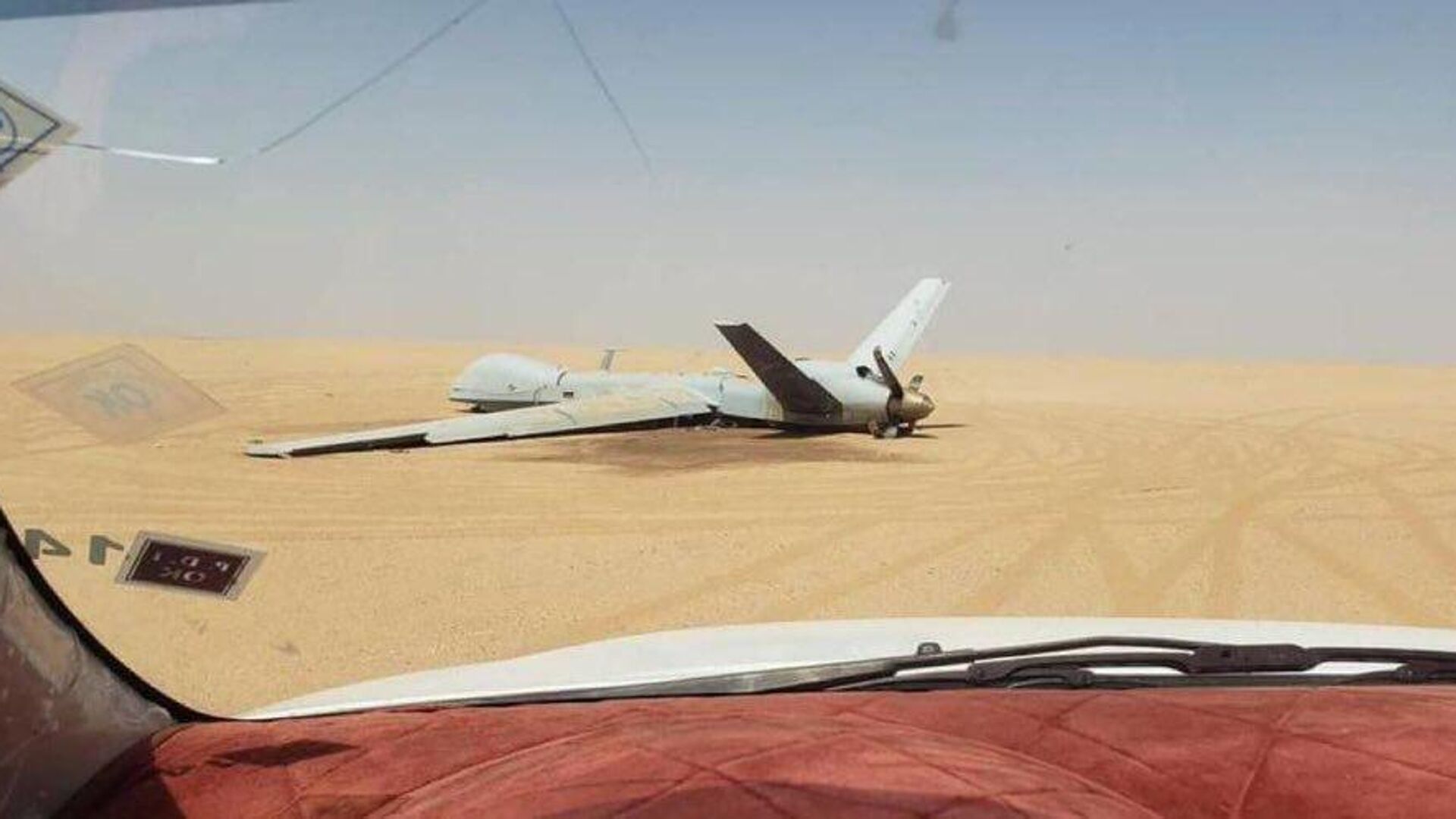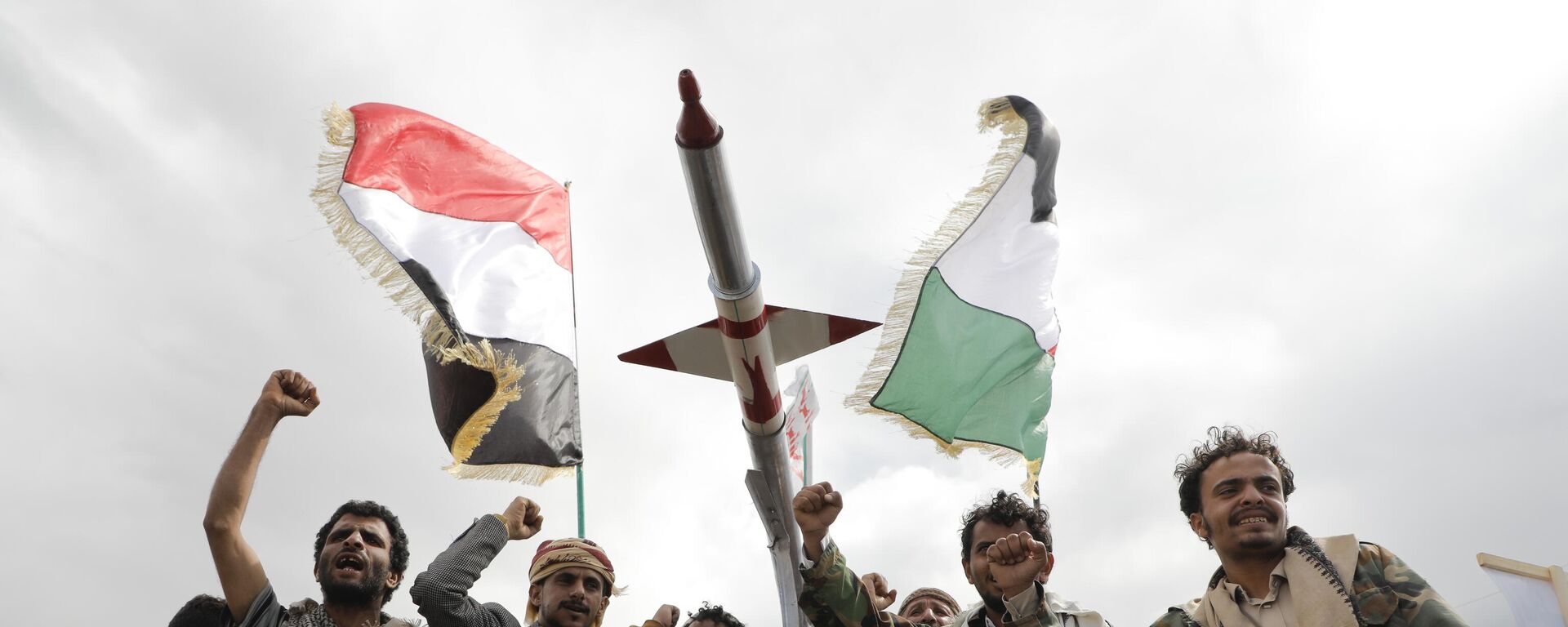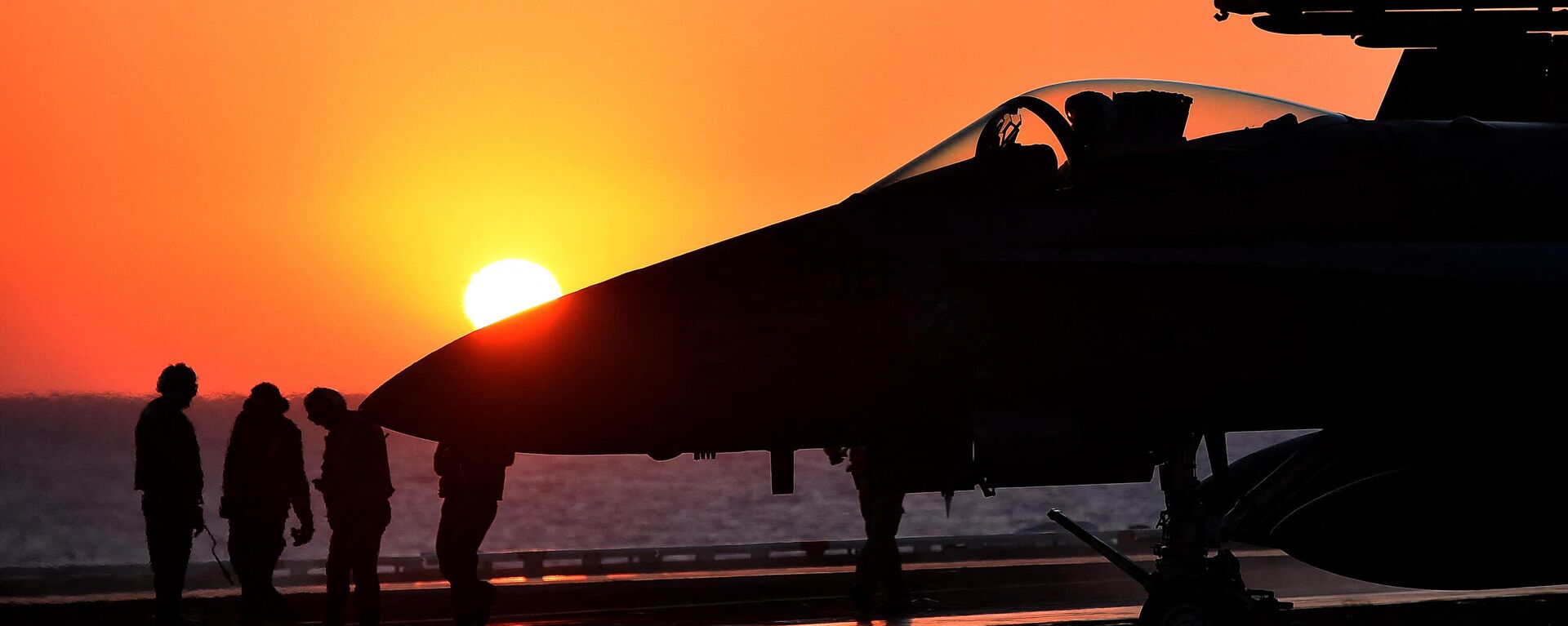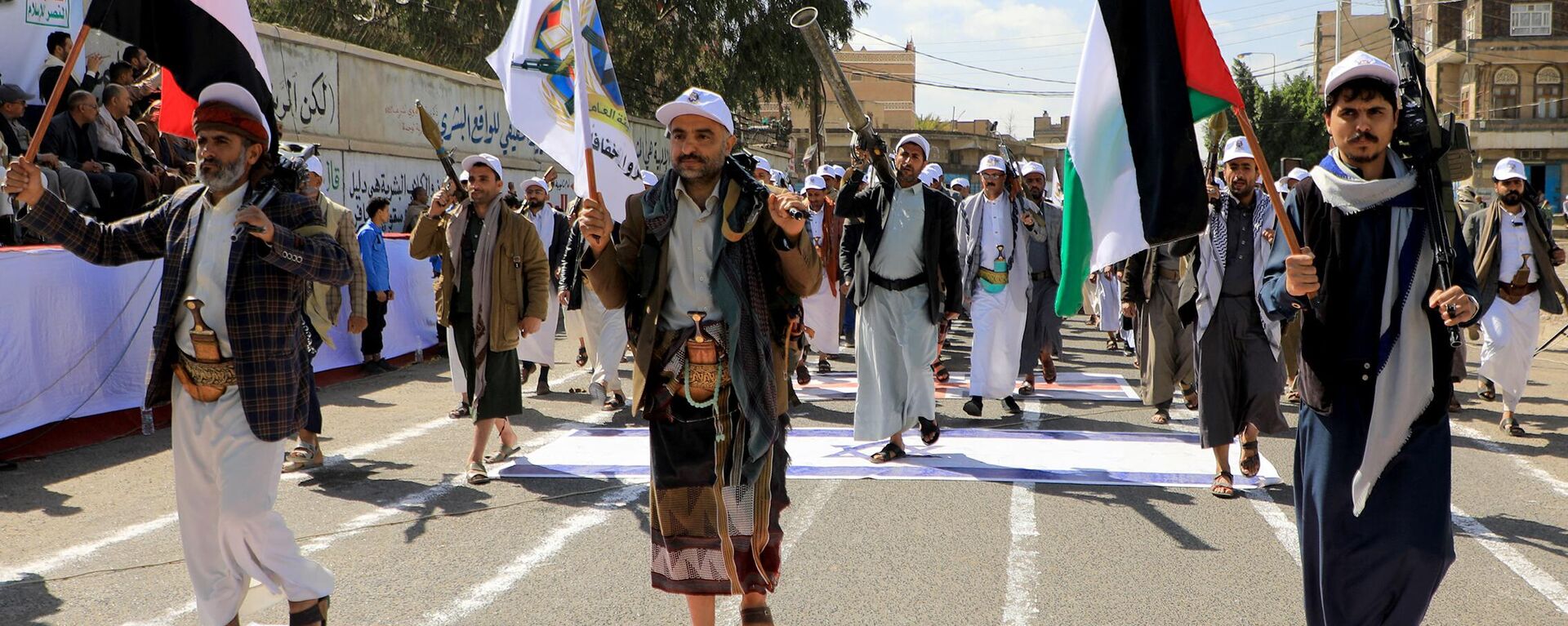https://sputnikglobe.com/20240531/why-houthis-dont-fear-the-reaper-everything-we-know-about-militias-air-defenses-1118720010.html
Why Houthis Don’t Fear the Reaper: Everything We Know About Militia’s Air Defenses
Why Houthis Don’t Fear the Reaper: Everything We Know About Militia’s Air Defenses
Sputnik International
Yemen’s Ansar Allah (lit. ‘Supporters of God’) fighters, better known as the Houthis, have shot down another US Reaper drone. How has a militia hailing from... 31.05.2024, Sputnik International
2024-05-31T17:38+0000
2024-05-31T17:38+0000
2024-05-31T17:38+0000
military
military & intelligence
aitech bizhev
yemen
sanaa
iran
nato
houthis
houthi
kub
https://cdn1.img.sputnikglobe.com/img/07e8/05/1f/1118721762_70:0:955:498_1920x0_80_0_0_38d17f8c6538ebaabfe3bf216134d209.jpg
The United States and Britain have lashed out over the Houthis’ embarrassing takedown of another of America’s $31 million apiece MQ-9 Reaper drones, killing at least 16 people (most of them civilians) and injuring 35 others in large-scale overnight airstrikes in Sanaa, Hodeidah and Taiz provinces late Thursday night.Houthi Political Bureau member Ali al-Qahoum vowed that the militia would retaliate with a “painful response” to the US-UK “acts of aggression,” and warned that “the American-British coalition will not be able to ward off our responses.”Nasruddin Amer, another member of the Houthi Political Bureau, said that “even if the whole world attacks Sanaa, we will never abandon Gaza,” – a reference to the militia’s ongoing partial-blockade of the Red and Arabian Seas to Israeli, Israeli-linked and allied commercial shipping in solidarity with Palestinians amid the Israeli military operation in the besieged Gaza Strip.Another Drone Bites the DustThe US-UK attacks came less than 48 hours after the Houthis shot down another Reaper drone – their sixth since the escalation of the Palestinian-Israeli crisis last October, on Wednesday. Footage posted to social media showed a Reaper laying on its belly in a desert somewhere in Marib province, its tail assembly partially broken, but the drone otherwise intact, with a group of militiamen, two of them barefoot, standing on top of the wreckage.The drone featured no visible markings, indicating that it was likely used by the CIA – which has been flying unmarked Reapers over Yemen since the 2000s, first against suspected al-Qaeda* terrorists in the country’s southeast, and then against the Houthis after the Shia militia established control over much of western Yemen, including Sanaa, in early 2015.Since then, the Houthis have racked up an impressive tally of downed Reapers, including:Put another way, between 2017 and the present, the militia has taken down a combined $279 million worth of Reapers, becoming by far the biggest threat to America’s killer drone program apart from accidents and mechanical failures.Other Aircraft Lost or Damaged by the HouthisReapers aren’t the only US and NATO-made aircraft proving vulnerable to the Houthis, who have engaged in a long slog against a coalition of Gulf countries attempting to restore Yemen’s ousted government since March 2015. According to a tally published by Islamic World News this week, Reapers make up less than a tenth of the Western aircraft, manned or unmanned, that have been shot down or damaged fighting Ansar Allah and other actors in Yemen. Others include:How Did the Houthis Get Their Air Defense Prowess?Modern-day Yemen got its start in the development of air defenses thanks to the Soviet Union. Moscow signed treaties of friendship and cooperation with both the Yemen Arab Republic (which makes up most of Houthi-controlled Yemen today) and the People’s Democratic Republic of Yemen, a separate state in what is today southern Yemen, in the 1960s.Accompanying diplomatic support and major economic and infrastructure assistance, friendship with the USSR meant weapons – including sophisticated ballistic missile, coastal defense, anti-tank, and anti-air missile tech. The latter included:The USSR also provided Yemen with an array of surveillance and target acquisition radars, including:Simple, Durable Soviet SAMs Perfect for Yemen’s Difficult Environment“During the Soviet period, our military specialists and advisors were widespread in Iraq, in Yemen, in Libya,” Lt. Gen. (ret.) Aytech Bizhev, the former deputy commander of the CIS Joint Air Defense System, recalled to Sputnik, commenting on the pervasiveness of Soviet air defenses in Yemen.The Kub proved particularly durable in Yemen thanks to its simplicity and reliability, Bizhev noted.The expert added that the Houthis have apparently found ways to convert their Soviet-era anti-aircraft missiles to use pure kerosene instead of traditional propellants – which require specialized factories and technical knowhow to manufacture.Technology TransfersConsequently, the Houthis appear to have boosted their air defense capabilities with a little help from their Iranian friends. To be clear: Tehran has officially rejected claims by the US and Britain that it’s been “providing arms” to the Yemeni militia, calling such allegations little more than “a pretext used by Washington and London to advance their short-sighted political plan and to justify and validate their illegal and aggressive actions against Yemen.”That said, Iran has not shied away from providing technical assistance to its Axis of Resistance partners, with Iranian semi-official news agency Tasnim publishing a bombshell report this week confirming that “Iran’s technical knowhow” for the production of anti-ship missiles “is now at the disposal of the Yemeni military forces.”What this means for Houthi air defenses is the provision of missile technology (but not ready-made missiles), with independent observers spotting what appear to be Yemeni-made copies of Iranian missiles like the Taer medium-range missile system, Iranian-designed radars like the Matla ul-Fajr-2 and Kashef-2, Misagh-2015 MANPADS and the unique Saqr-1 hybrid anti-aircraft missile and loitering munition.Given Iranian familiarity with an array of Soviet air defense systems thanks to decades of cooperation with Russia in this field, it can’t be ruled out that Iranian specialists may have given the Houthis important tips for the modernization of their aging Soviet SAM and radar systems, although direct evidence on such efforts have not been publicized, for obvious reasons.Technology Means Nothing Without People to Use ItThe Houthis have amassed plenty of experience against NATO weaponry, including Reapers, using both older equipment and equipment modified and modernized by domestic and foreign specialists, but the militia's SAMs would mean nothing without the experienced fighters who man them, former DoD analyst and retired US Air Force Lt. Col. Karen Kwiatkowski told Sputnik."These guys are experienced using older equipment, but using it against some of the modern stuff. I know the night vision and infrared targeting - they have ways of tracking these Reapers and using their capabilities basically to the maximum extent possible. So it's really testimony to what happens when you have an experienced set of soldiers or air defense experts," Kwiatkowski said.The Houthis have also proved their engineering prowess, and it would be a mistake to underestimate the militia's proficiency in the modification and examination of equipment, including captured weaponry, Kwiatkowski said.The Pentagon has shown a dangerous tendency to underestimate its adversaries, with the Houthis proving no exception, Kwiatkowski said.* A terrorist group outlawed in Russia and many other countries.
https://sputnikglobe.com/20240531/houthis-attack-us-aircraft-carrier-in-red-sea-after-us-uk-strikes---movement-member-1118716029.html
https://sputnikglobe.com/20240531/houthis-threatens-to-hit-targets-in-red-arabian-seas-after-us-uk-strikes-on-yemen-1118714744.html
https://sputnikglobe.com/20240525/us-expends-530-munitions-1-bln-fighting-houthi-hellfire-raining-down-on-its-carrier-group-1118634310.html
https://sputnikglobe.com/20240515/houthis-have-defeated-american-goliath---uk-media-1118452721.html
yemen
sanaa
iran
soviet union
ussr
Sputnik International
feedback@sputniknews.com
+74956456601
MIA „Rossiya Segodnya“
2024
News
en_EN
Sputnik International
feedback@sputniknews.com
+74956456601
MIA „Rossiya Segodnya“
Sputnik International
feedback@sputniknews.com
+74956456601
MIA „Rossiya Segodnya“
military & intelligence, aitech bizhev, yemen, sanaa, iran, nato, houthis, houthi, kub, mq-9 reaper, soviet union, ussr, air defense, missile
military & intelligence, aitech bizhev, yemen, sanaa, iran, nato, houthis, houthi, kub, mq-9 reaper, soviet union, ussr, air defense, missile
Why Houthis Don’t Fear the Reaper: Everything We Know About Militia’s Air Defenses
Yemen’s Ansar Allah (lit. ‘Supporters of God’) fighters, better known as the Houthis, have shot down another US Reaper drone. How has a militia hailing from one of the poorest countries in the world, many of them literally fighting barefoot, been able to create an air defense system sophisticated enough to challenge a superpower? Sputnik explores.
The United States and Britain have
lashed out over the Houthis’ embarrassing takedown of another of America’s $31 million apiece MQ-9 Reaper drones, killing at least 16 people (
most of them civilians) and injuring 35 others in large-scale overnight airstrikes in Sanaa, Hodeidah and Taiz provinces late Thursday night.
Houthi Political Bureau member Ali al-Qahoum
vowed that the militia would retaliate with a “painful response” to the US-UK “acts of aggression,” and warned that “the American-British coalition will not be able to ward off our responses.”
Nasruddin Amer, another member of the Houthi Political Bureau, said that “even if the whole world attacks Sanaa, we will never abandon Gaza,” – a reference to the militia’s ongoing partial-blockade of the Red and Arabian Seas to Israeli, Israeli-linked and allied commercial shipping in solidarity with Palestinians amid the Israeli military operation in the besieged Gaza Strip.
Another Drone Bites the Dust
The US-UK attacks came less than 48 hours after the Houthis shot down another Reaper drone – their sixth since the escalation of the Palestinian-Israeli crisis last October, on Wednesday. Footage posted to social media showed a Reaper laying on its belly in a desert somewhere in Marib province, its tail assembly partially broken, but the drone otherwise intact, with a group of militiamen, two of them barefoot, standing on top of the wreckage.
The drone featured no visible markings, indicating that it was likely
used by the CIA – which has been flying unmarked Reapers over Yemen since the 2000s, first against suspected al-Qaeda* terrorists in the country’s southeast, and then against the Houthis after the Shia militia established control over much of western Yemen, including Sanaa, in early 2015.
Since then, the Houthis have racked up an impressive tally of downed Reapers, including:
an MQ-9 shot down on October 1, 2017 over Sanaa,
another Reaper destroyed on June 6, 2019 somewhere over Yemen, this one using a modified Soviet-era 2K12 Kub medium-range surface-to-air missile system, according to United States Central Command (CENTCOM),
a third Reaper downed on August 21, 2019 over Dhamar, southwestern Yemen, this time using an improved domestic variant of the Kub known as the Fater-1 (lit. ‘Innovator-1’),
another MQ-9, belonging to the US Air Force destroyed over the Red Sea on November 8, 2023,
a fifth Reaper downed over al-Hudaydah city, western Yemen on February 19,
a sixth MQ-9 destroyed over Saada province in northwestern Yemen,
another Reaper shot out of the sky on May 17 over Marib province,
an eighth MQ-9 destroyed over Sanaa on May 24,
and finally, the aforementioned ninth Reaper eliminated over Marib on May 29.
Put another way, between 2017 and the present, the militia has taken down a combined $279 million worth of Reapers, becoming by far the biggest threat to America’s killer drone program apart from accidents and mechanical failures.
Other Aircraft Lost or Damaged by the Houthis
Reapers aren’t the only US and NATO-made aircraft proving vulnerable to the Houthis, who have engaged in a long slog against a coalition of Gulf countries attempting to restore Yemen’s ousted government since March 2015. According to a tally
published by Islamic World News this week, Reapers make up less than a tenth of the Western aircraft, manned or unmanned, that have been shot down or damaged fighting Ansar Allah and other actors in Yemen. Others include:
a US UH60 Black Hawk helicopter lost off the coast of Yemen during a mysterious ‘training mission’ on August 26, 2017,
three American-made F-16 fighter jets (belonging to Morocco, Bahrain and Jordan, lost over Yemen in May 2015, December 2015, and February 2017, respectively),
at least 64 scout, strike and helicopter drones, mostly operated by Gulf coalition forces targeting the Houthis, including US and European-made MQ-1 Predators, Scan Eagles, Seeker 400 surveillance UAVs, and other drones,
11 manned Western-made Gulf coalition aircraft (on top of the aforementioned F-16), including Mirage 2000, Eurofighter Typhoon, F-15 and Tornado jets, as well as Ah-64 Apache, AH-60, S-70 Black Hawk and SA-365 helicopters.
How Did the Houthis Get Their Air Defense Prowess?
Modern-day Yemen got its start in the development of air defenses thanks to the Soviet Union. Moscow signed treaties of friendship and cooperation with both the Yemen Arab Republic (which makes up most of Houthi-controlled Yemen today) and the People’s Democratic Republic of Yemen, a separate state in what is today southern Yemen, in the 1960s.
Accompanying diplomatic support and major economic and infrastructure assistance, friendship with the USSR meant weapons – including sophisticated ballistic missile, coastal defense, anti-tank, and anti-air missile tech. The latter included:
the aforementioned 2K12 Kub/Kvadrat (NATO classification SA-6 ‘Gainful’) tracked missile system, modernized by the Houthis into a FrankenSAM using 3M9 missiles known as the Fater-1,
the S-75 Dvina (NATO reporting name SA-2 Guideline), a high-altitude air defense system,
the S-125 Neva/Pechora (NATO reporting name SA-3 Goa) short-range SAM, upgraded variants of which are known to have been delivered to both Yemens in the 70s and 80s,
the 9K31 Strela-1 (NATO classification SA-9 Gaskin) high mobility short-range low-altitude vehicle-mounted SAM system,
the R-60 Molniya (NATO reporting name AA-8 Aphid) - an air-to-air missile system once used by Yemen’s MiG-21s, MiG-29s and Su-22M3 aircraft, converted by engineers from the
Yemen Missile Research and Development Center into a SAM that can be launched from the beds of pickup trucks,
the R-73 (NATO reporting name AA-11 Archer) – another Soviet air-to-air missile modified into a SAM, known as the Thaqib-1 (lit. ‘Piercer’),
the R-27 and R-77 (NATO classification AA-10 Alamo and AA-12 Adder) beyond visual range air-to-air missiles, converted by Yemen into the Thaqib-2 and Thaqib-3, respectively,
the 9K32 Strela-2, 9K34 Strela-3 and 9K38 Igla man-portable surface-to-air missile systems (NATO codename SA-7 Grail, SA-14 Gremlin and SA-18 Grouse, respectively),
12.7 and 14.5 mm Soviet towed anti-aircraft guns and ZU-23 towed 22 mm anti-aircraft twin-barreled autocannons – whose quantities in Yemen are estimated to number in the hundreds.
The USSR also provided Yemen with an array of surveillance and target acquisition radars, including:
the P-18 (NATO codename Spoon Rest D) and P-19 Danube (NATO reporting name Flat Face B) 2d UHF radar systems,
the 1S91 SURN (NATO designation Straight Flush) 26 kW G/H band radar with a range of up to 75 km for the Kub and Kvadrat missile systems,
the PRV-13 (NATO codename Odd Pair) Soviet height-finding (altimeter) radar –
spotted at a military parade in Sanaa in 2022.
Simple, Durable Soviet SAMs Perfect for Yemen’s Difficult Environment
“During the Soviet period, our military specialists and advisors were widespread in Iraq, in Yemen, in Libya,” Lt. Gen. (ret.) Aytech Bizhev, the former deputy commander of the CIS Joint Air Defense System, recalled to Sputnik, commenting on the pervasiveness of Soviet air defenses in Yemen.
“The countries of the Middle East were in the zone of interests of the Soviet Union. These were countries with which we had very friendly relations. Therefore, we helped, assisted in the creation of air defense systems for them. We created it and they bought our weapons, and they still have them there. They were put on combat duty in very difficult climactic conditions – in the heat, in sandstorms, under the scorching Sun they carried out the tasks that were set before them,” Bizhev said.
The Kub proved particularly durable in Yemen thanks to its simplicity and reliability, Bizhev noted.
“When we’re talking about unmanned aerial vehicles, it’s not particularly difficult to shoot them down, because they have a fairly large effective reflective surface area, almost always flying without interference, and at relatively low speeds,” Bizhev explained.
The expert added that the Houthis have apparently found ways to convert their Soviet-era anti-aircraft missiles to use pure kerosene instead of traditional propellants – which require specialized factories and technical knowhow to manufacture.
Soviet arms deliveries stopped in the early 1990s when Yemen unified and the USSR collapsed, and Russia is not known to have supplied the southern Arabian nation with air defense equipment in any significant quantities of weapons in the years and decades since. With over thirty years passing, it’s clear that the Soviet systems the Houthis inherited would not have been enough on their own to enable the militia to target sophisticated Western drones, aircraft and helicopters en masse. Advanced air defense equipment has a tendency to become outdated, missiles exhaust their service life, spare parts become scarce, and service technicians unavailable.
Consequently, the Houthis appear to have boosted their air defense capabilities with a little help from their Iranian friends. To be clear: Tehran has
officially rejected claims by the US and Britain that it’s been “providing arms” to the Yemeni militia,
calling such allegations little more than “a pretext used by Washington and London to advance their short-sighted political plan and to justify and validate their illegal and aggressive actions against Yemen.”
That said, Iran has not shied away from providing technical assistance to its Axis of Resistance partners, with Iranian semi-official news agency Tasnim publishing a
bombshell report this week confirming that “Iran’s technical knowhow” for the production of anti-ship missiles “is now at the disposal of the Yemeni military forces.”
Iran’s empowerment of regional “resistance groups by providing them with modern technologies” has “led to the formation of an integrated command and control center in the region, specifically in the drone and missile sectors,” Tasnim revealed.
What this means for Houthi air defenses is the provision of missile technology (but not ready-made missiles), with independent observers
spotting what appear to be Yemeni-made copies of Iranian missiles like the Taer medium-range missile system, Iranian-designed radars like the Matla ul-Fajr-2 and Kashef-2, Misagh-2015 MANPADS and the unique Saqr-1
hybrid anti-aircraft missile and loitering munition.
Given Iranian familiarity with an array of Soviet air defense systems thanks to decades of cooperation with Russia in this field, it can’t be ruled out that Iranian specialists may have given the Houthis important tips for the modernization of their aging Soviet SAM and radar systems, although direct evidence on such efforts have not been publicized, for obvious reasons.
Technology Means Nothing Without People to Use It
The Houthis have amassed plenty of experience against NATO weaponry, including Reapers, using both older equipment and equipment modified and modernized by domestic and foreign specialists, but the militia's SAMs would mean nothing without the experienced fighters who man them, former DoD analyst and retired US Air Force Lt. Col. Karen Kwiatkowski told Sputnik.
"These guys are experienced using older equipment, but using it against some of the modern stuff. I know the night vision and infrared targeting - they have ways of tracking these Reapers and using their capabilities basically to the maximum extent possible. So it's really testimony to what happens when you have an experienced set of soldiers or air defense experts," Kwiatkowski said.
"I won't say necessarily that the equipment they have is top of the line, but the combination of very experienced fighters who understand not just Western technology, but Western tactics and usage of equipment like the Reaper, it all comes together and makes them very successful at a very low cost against very expensive equipment that we have," the observer stressed.
The Houthis have also proved their engineering prowess, and it would be a mistake to underestimate the militia's proficiency in the modification and examination of equipment, including captured weaponry, Kwiatkowski said.
"Not only that...they have friends, and their friends can assist in any examination, analysis and potentially reverse engineering of those [weapons]. And this isn't the first of these Reaper drones that they've taken out," she noted, pointing out that the UAV has proven ill-suited for operations in areas with air defenses that actually function.
The Pentagon has shown a dangerous tendency to underestimate its adversaries, with the Houthis proving no exception, Kwiatkowski said.
"We think the Yemenis are nothing. Well, in that battlefield, the Yemenis are a near-peer competitor," she summed up.
* A terrorist group outlawed in Russia and many other countries.








